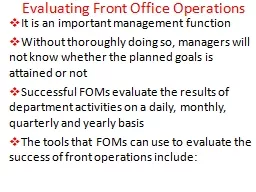

It is an important management function Without thoroughly doing so managers will not know whether the planned goals is attained or not Successful FOMs evaluate the results of department activities on a daily monthly quarterly and yearly basis ID: 447538
Download Presentation The PPT/PDF document "Evaluating Front Office Operations" is the property of its rightful owner. Permission is granted to download and print the materials on this web site for personal, non-commercial use only, and to display it on your personal computer provided you do not modify the materials and that you retain all copyright notices contained in the materials. By downloading content from our website, you accept the terms of this agreement.
Slide1
Evaluating Front Office Operations
It is an important management function
Without thoroughly doing so, managers will not know whether the planned goals is attained or not
Successful
FOMs
evaluate the results of department activities on a daily, monthly, quarterly and yearly basis
The tools that
FOMs
can use to evaluate the success of front operations include:Slide2
Evaluating Front Office Operations
The Daily Operations Report
Occupancy Ratios
Rooms Revenue Analysis
The Hotel Income Statement
The Rooms Schedule
Rooms Division Budget Reports
Operating Ratios
Ratio StandardSlide3
The Daily Operations Report
Also known as
Manager’s Report / Daily Revenue Report
It summarizes the hotel’s financial activities during a 24 hour period
It provides a means to reconcile cash, bank accounts, revenue and accounts receivableSlide4
Occupancy Ratio
It measures the success of the front office in selling the hotel's primary product, i.e.
GUESTROOMS
The following rooms statistics must be gathered to calculate basic occupancy ratios:
No. of rooms available for sale
No. of rooms sold
No. of guests
No. of guest per room
Net rooms revenueSlide5
Occupancy Ratio
Occupancy Percentage =
No. of Rooms Occupied
No. of Rooms Available
Multiple Occupancy Ratio =
No. of Rooms Occupied by
More Than One Guest
No. of Rooms OccupiedSlide6
Occupancy Ratio
Average Guests per Room Sold =
No. of Guests______
No. of Rooms Sold
Average Daily Rate =
Total Room Revenue_____
No. of Rooms sold
RevPAR
(Revenue per Available Room) =
Total Room Revenue_______
No. of Available
RoomsSoldSlide7
Occupancy Ratio
RevPac
(Revenue per Available Customer =
Total Revenue______
No. of Guests
Average Rate per Guest =
Total Room Revenue_____
No. of Rooms GuestsSlide8
Room Revenue Analysis
FO staff members are expected to sell rooms at rack rate unless a guest qualifies for an authorized discounted room rate
A room rate variance report lists those rooms that have been sold at other than their rack rates
This report helps FO mgmt. to review the performance of the FO staff
The other way to evaluate the sales effectiveness of the FO staff by
FOM
is to generate a YIELD STATISTICSlide9
Room Revenue Analysis
Yield
Statistic
is the ratio of actual rooms revenue to potential rooms revenue
In other words, it is the amount of room revenue that can be generated if all the rooms in the hotel are sold at rack rate on a given day, month or year
Yield Statistic =
Actual Room Revenue____
Potential Rooms RevenueSlide10
The Hotel Income Statement
It provides important financial information about the results of hotel operations for a given period of time that is used by the management to evaluate the overall success of operations
It is an important financial indicator of operational success and profitability
The hotel income statement relies in part on detailed FO information that is supplied through the room scheduleSlide11
The Hotel Income Statement
The amount of income generated by the rooms division is determined by subtracting payroll and related expenses
Revenue generated by the rooms division is usually the largest single amount produced by revenue center with in a hotelSlide12
The Rooms Schedule
The hotels statement of income shows only summary information
The separate department income statement prepared by each revenue center provide more detail
Departmental income statements are called ‘Schedules’ and are referenced on the hotel’s statement of incomeSlide13
Rooms Division Budget Report
Hotel’s accounting division prepares monthly budget reports that compare actual revenue and expense figures with budgeted amounts
It helps in evaluating front office operations whether it is favorable or unfavorable
A typical budget report format should include both monthly variances and year to date variances for all budget items Slide14
Rooms Division Budget Report
Favorable
Variance
:
Revenue: Actual exceeds budget
Expenses: Budget exceeds actual
Unfavorable
Variance
:
Revenue: Budget exceeds actual
Expenses: Actual exceeds budget
For e.g. the actual amount of salaries and wages for Room Division personnel for a given month was $20, 826, while the budgeted amount was $18, 821Slide15
Rooms Division Budget Report
It
resulted in an unfavorable balance of $2,005
Percentage variances alone can also be deceiving
Any budgeting process is unlikely to be perfect
So
FOM
should analyze only significant variances and take action
GM and Controller normally provides criteria and determines which variances
are significantSlide16
Operating Ratios
It assists managers in evaluating the success of front office operations
Payroll and related expenses tends to be the largest single expenses for the entire hotel
For control, labor costs must be analyzed on a departmental basis
Room sales fluctuates but payroll and related expenses relatively remains constant
Hence any differences between actual and budgeted labor cost percentages must be carefully investigatedSlide17
Ratio Standards
Operating ratios are meaningful when compared against useful criteria such as:
Planed ratio goals
Corresponding historical ratios
Industry averages
Ratio standards are only indicators and
not solution
When ratios vary significantly form planned goals, previous results, or industrial averages, they indicate that problem may exist
More analysis and investigations are necessary to determine appropriate corrective actions